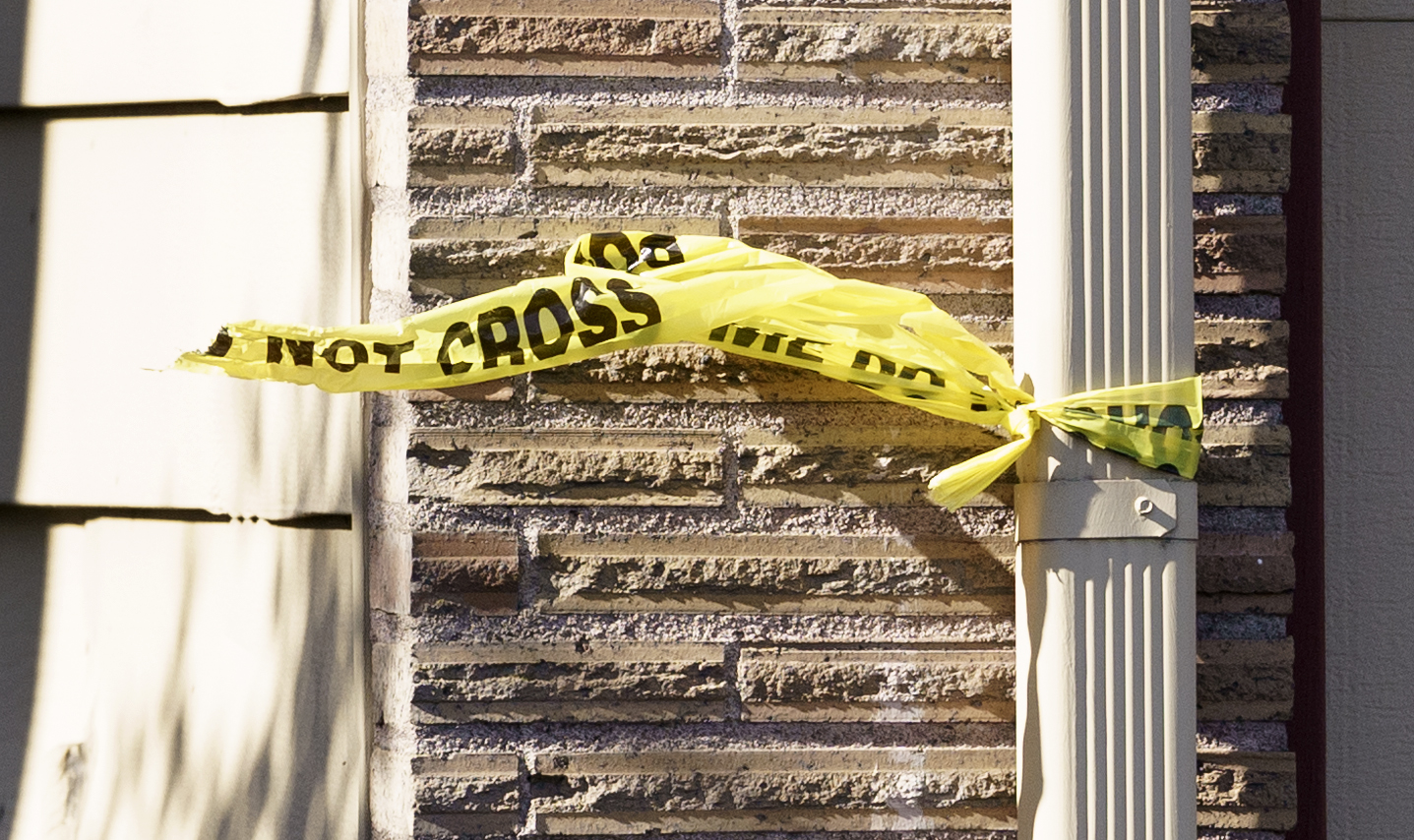
A piece of police tape remains tied to the gutter at Rose City Terrace apartments, where Benjamin Jeffrey Smith lives. Smith is suspected of shooting and killing social justice demonstrator Brandy “June” Knightly, 60, and injuring four others during a confrontation on Feb. 19.
Kristyna Wentz-Graff / OPB
As Portland homicide rates have soared in recent years, the Portland Police Bureau has struggled to keep up.
The latest figures, released Thursday, show Portland officers are clearing fewer cases as the number of killings has skyrocketed. Clearing a homicide typically means arresting someone for the crime. Sometimes a homicide can be cleared “exceptionally,” meaning detectives believe they have enough evidence but are unable to make an arrest, for example, if the suspect has died or the witnesses are unwilling to cooperate with the prosecution.
In 2021, amidst a record number of killings, detectives cleared just 48% of the city’s homicides, leaving 47 of the city’s 90 homicides unsolved, according to PPB’s latest data. The figure continues a dramatic decline in the bureau’s homicide clearance rates. In 2017, detectives exceeded the national average by 20 percentage points, solving around 81% of the city’s 27 killings. By 2020, the agency was just a few points above the national average, clearing around 59% of that year’s 54 homicides.
National data isn’t available yet for 2021, so it’s not clear how Portland stacks up.
The Portland Police Bureau doesn’t specify how each homicide was cleared in its annual report, but police bureau spokesperson Sgt. Kevin Allen said the agency doesn’t clear homicides exceptionally if a suspect is identified but not arrested, only if the homicide is determined to be self defense or if a grand jury declines to indict a suspect.
Police officials declined an interview request.
Because of the dramatic increase in homicides in 2021, the bureau assigned an additional six detectives to its homicide unit.

Portland police officers investigate a shooting on Oct. 26, 2021 in North Portland.
Jonathan Levinson / OPB
Despite outperforming their colleagues for years, the bureau’s declining performance of late brings the agency more in line with a nationwide decline that goes back to the 1980s, according to the nonprofit Murder Accountability Project, which uses FBI data and public records requests to track U.S. homicides.
“The rate at which we solve homicides by making an arrest has been declining steadily for 50 years,” director Thomas Hargrove said. “In 2020, the most recent year for which we have complete data, the national average for clearing homicides according to the FBI was 54%, making it nearly a 50-50 coin flip whether any particular murder will be cleared.”
Up until recently, Portland’s homicide detectives were performing at levels not seen nationally since the 1960s, clearing over 80% of the city’s homicides. In 2018, when Portland cleared 81% of the homicides in the city, Oakland, California, officers cleared just 40%, New Orleans 41.5% and Seattle cleared 68%, according to FBI data.
Experts disagree on why clearance rates have dropped. Hargrove said as Americans have left rural communities for larger urban centers, crime has followed. And because crimes in cities more often can involve people who were previously unknown to each other, they are less likely to be solved.
Policing has also evolved dramatically since the 1960s when standards for arrest and collecting evidence were far looser. More rigid standards, which came about largely because of civil rights abuses, might have impacted clearance rates over time.
In 2020, for reasons researchers still don’t fully understand, homicides nationwide spiked, sending clearance rates plummeting.
Portland Mayor Ted Wheeler recently announced a $2.4 million dollar initiative to address gun violence in the city, the latest in a series of efforts to address shootings since they began to sharply rise in 2019.
Evidence suggests local efforts to curb gun violence often have limited success. And as homicides increase and more than half go unsolved, the city could spiral. According to Hargrove, data suggests that when clearance rates drop, homicide rates increase.
“You have a growing number of killers walking the street, you have a growing number of people who cared about murdered people for whom there was no justice. And so sometimes there’s a move to take justice into your own hands,” Hargrove said. “Murder begets murder, especially unsolved murder.”


